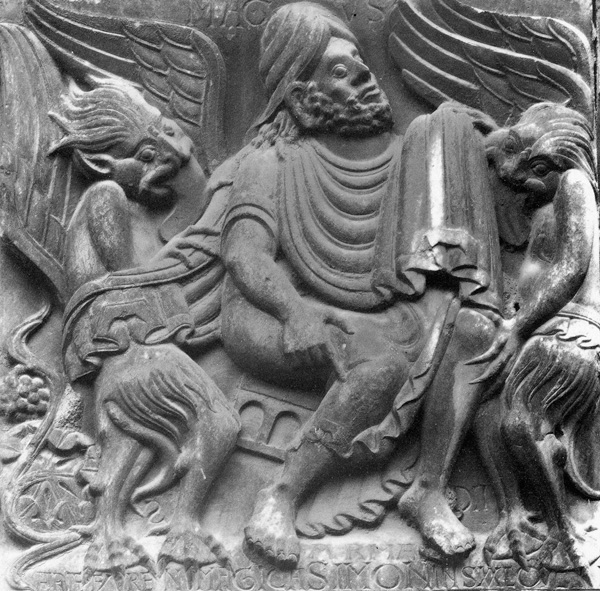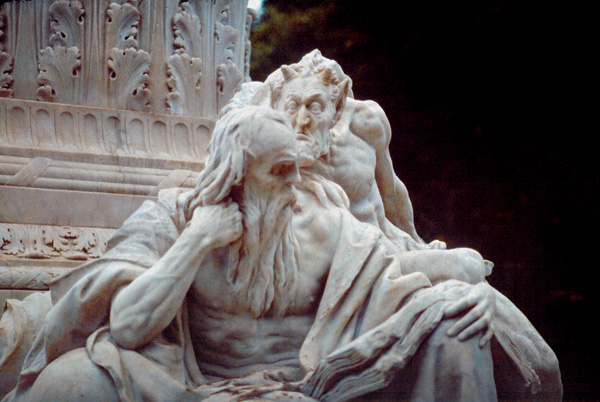A Model for Faust?
Sidebar to: The Fall and Rise of Simon Magus35

Since the early 16th century, a tragic and sinister story has weaved its way through western literature, art and music—the legend of a man who makes a pact with the devil and then has to come to terms with the contract he signed. It’s the legend of Johannes Faustus.
Faustus was apparently a historical character who lived in Germany during the early 16th century. A student of divinity, Faustus claimed to have extraordinary powers. In his imagination, he was a necromancer (someone who communicates with the dead) and a practitioner of black magic and sorcery. Though the historical Faustus was nothing more than a braggart and a charlatan, his legend flourished.
The earliest collection of the tales of Faust (as the name is often abbreviated) came in 1587 in an anonymous work titled the Historie of the Damnable Life and Deserved Death of Dr. John Faustus. The legend was soon picked up by English playwright Christopher Marlowe, a contemporary of Shakespeare and Queen Elizabeth, and according to rumor, a spy for Her Majesty’s Secret Service and a man of rather unorthodox religious opinion. Marlowe’s version of Faust’s story, the play The Tragicall History of D. Faustus (1604), was so eloquent and dramatic that it became the model for the many versions of Faust’s story that followed. It is the story of a man who trades his soul to the devil in exchange for a period of ultimate knowledge and power.
Marlowe’s Faust is not simply a charlatan. He is a tragic hero, a superman, the archetype of the Renaissance man. Where did Marlowe get the idea to depict Faust as a powerful sorcerer whose willingness to do anything for knowledge and power leads him to the dark side? Perhaps from the apocryphal legends of Simon Magus, the first-century magician who challenged God and clashed with Peter in magical feats of sorcery. This connection may derive from Simon’s use of the Latin faustus (“the favored one”) for himself.
There were many sources available to Marlowe concerning the life of Simon Magus. Probably the most important was the The Golden Legend (Legende Aurea), a popular collection of tales of the saints by the 13th-century archbishop of Genoa, Jacobus de Voragine.
As literary critic Beatrice Daw Brown has pointed out, the careers of the two magicians, Simon Magus and Marlowe’s Faust, follow the same pattern, and their lives have many parallels.1 Both are extremely powerful sorcerers able to withstand fire, to move objects without touching them and, most importantly, to evoke the spirits of the dead. Both defy God, Faust with his pact with the Devil and Simon with his arch-heresy of proclaiming himself the Christ. Both travel to Rome, both perform their miracles before the emperor and both have demons at their beck and call. Simon Magus has demons who aid and carry him (shown licking and tormenting him in a relief from the St. Sernin Cathedral in Toulouse, France). Faust has Mephistopheles, a servant of Lucifer, who gives him the power to do his magical acts. (Mephistopheles peers menacingly over Faust’s shoulder in the statue from the Villa Borghese in Rome, celebrating Johann Wolfgang von Goethe, who penned his own version of the Faust legend.) Simon Magus and Faust both attempt to fly, Faust in Venice and Simon at Rome, and both fail.

The two figures also have as a companion a semidivine woman named Helen. In the Magus stories, she is a reincarnation of Helen of Troy. In the Faust legends, she is Helen of Troy. In Marlowe’s Doctor Faustus, in the famed poetic drama of Goethe, and in the operas of Gounod and Berlioz, Mephistopheles employs the most beautiful woman in antiquity to seduce Dr. Faust into the occult realms in Faust’s search for wisdom. Thus Marlowe writes: “Was this the face that launched a thousand ships / And burnt the topless towers of Ilium?”
And finally Simon Magus and Faust both meet an inglorious and violent death. Simon Magus tries to fly but crashes to the ground with broken limbs. Faust’s body is found the morning after his pact ends, mangled and torn to pieces.
In Marlowe’s play, Faust’s final soliloquy, the most moving of the entire work, evokes the fall of Simon Magus. In the last hour before his payment comes due, Faust laments: “The starres move still, time runs, the clocke wil strike, / The deuil wil come, and Faustus must be damned / O Ile leape up to my God: who pulles me downe?”—K.E.M.
